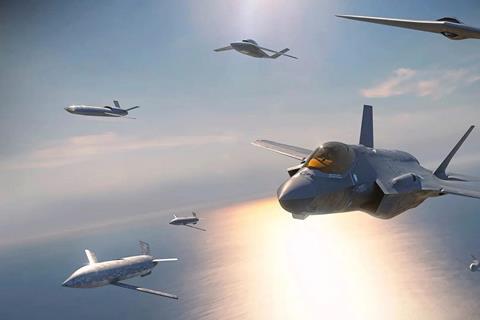The Center for Strategic and International Studies (CSIS) has outlined the importance of the correct command and control (C2) balance for collaborative combat aircraft (CCAs) in combat scenarios.
When designing future operations involving CCAs, commanders will need to balance operational effectiveness against tactical responsiveness, according to a new CSIS report.

The report’s authors offer scenarios where CCAs operated by the US military may be subject to different levels of C2.
The defensive counterair mission, for example, will place more emphasis on centralised C2, where the coordination of manned aircraft, CCAs, and surface units is necessary to defend objectives. The recent coordinated defence of Israel against massed Iranian drone and missile strikes highlights the criticality of coordination in these missions.
The suppression of enemy air defences and offensive counterair, on the other hand, will require CCAs to demonstrate greater tactical responsiveness.
The report gives the example of manned fighters detaching their CCAs to harass a large force of enemy fighters. This allows the manned aircraft to retreat and assess the situation.
During interdiction campaigns where the mission is to disrupt the enemy’s combat potential through strikes on the enemy’s logistic capabilities, the emphasis will be on more centralised C2, with CCA operations tightly coordinated with other capabilities.
“CCAs could become part of a larger joint fires scheme for interdicting lines of communications,” says the report.
“They could carry a mix of electronic attack payloads and air-ground (or air-sea) munitions, which work alongside long-range strike assets currently field by the Marine Littoral Regiment or the Army’s Multi-Domain Task Force.”
Close air support of troops, however, requires a high-level of tactical responsiveness. Moreover, the report foresees CCAs being controlled by joint terminal attack controllers on the ground.
The report offers an example of an enemy trying to break out of a beach head.
“This breakout would likely involve a concentration of artillery and air defence moved forward to support ground formations, with air-launched effects and loitering munitions serving as an advanced guard,” says the report.
“Containing the breakthrough would require forward JTACs coordinating [close air support] and other joint fire support to destroy, disrupt, suppress, fix, harass, neutralize, or delay advancing enemy columns in support of the ground commander’s defensive plan. The fog, friction, and chaos of the ground battle undermine operational effectiveness and put a premium on tactical responsiveness.”
The report adds that developing C2 for CCAs will require a large amount of experimentation by US forces, preferably working alongside allies. The big challenge facing planners will be pairing humans with machines.
“Determining the optimal C2 architecture for executing mission command through CCA networks should be a national security priority,” the report concludes.


























